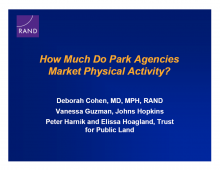We are pleased to announce an exciting new alliance between Active Living Research and GP RED to co-host and coordinate...
How Much Do Park Agencies Market Physical Activity?

Presentation at the 2010 Active Living Research Annual Conference
Background:
Marketing is a catalyst for consumer behavior and most business ventures cannot succeed without a healthy marketing effort. Hundreds of millions are spent on promoting leisure activities especially those that are sedentary, including attracting people to use electronic media. Little is known about how much marketing is devoted to promoting physical activity, particularly by public recreational facilities and parks, which are accessible to at least 80% of all Americans.
Objectives:
To assess the marketing and outreach efforts of the largest park systems in the United States.
Methods:
Building on a national survey conducted by the Trust for Public Land, we contacted the 72 largest city park agencies by phone and email, requesting copies of their marketing plans. We called each agency at least 6 times over a 7 week period. Once we received the marketing plans, we analyzed whether the following elements were included: consideration of brand, image, or logo; how services are positioned in the community; a description of services; whether physical activity is explicitly promoted; short and long term goals; a list of distribution channels and communication strategies, evaluation plans, and budget. As a comparison we also looked at the amount of marketing dollars spent by health clubs including Bally’s, Town Sports Int., Life Time Fitness, Equinox Fitness, and the Sports Club the companies published in annual reports.
Results:
The park agencies studied served populations from over 8 million (NYC) to about 250,000 (Henderson, NV) and encompassed from 41 to 4,157 park units (average of 269 park units) in 357 to >500,000 acres (Anchorage). Only a small percentage of park systems (20.8%) had formal or written marketing plans. In 2007 marketing budgets were very low and ranged from 0 to over 2 million (Chicago and NYC), though among the 43 that provided budgets the average was about $271,000 (about $909/park). Eight park systems had no marketing departments. We received marketing plans from 15 agencies. Of 72 agencies contacted 32 (44%) had no written plans and 24 did not respond to our request. Analysis of the marketing plans received showed that all 15 park agencies had short term goals, but only 3 (20%) specified long term goals. Only 6 (40%) parks explicitly planned to promote physical fitness. The top short term goals among the 15 marketing plans received were increasing public awareness (60%) and increasing participation or involvement in park programs (53.3%). The most popular distribution channels were the park website (93.3%), brochures (60%), and newsletters/press releases (60%). Only 6 agencies described the benefits of park services in their marketing plan, including improving health. In contrast, marketing budgets for private health clubs were much higher: Bally’s with 375 facilities spent $50 million in 2007, Town Sports with 166 facilities spent $7.9 million in 2008, and Sports Club with only 4 facilities spent $700,000 in 2006.
Conclusions:
If marketing is the engine that drives consumer behavior, park agency marketing efforts lack sufficient fuel to overcome the competition it faces from sedentary leisure activities. While parks are generally not a revenue-producing component of government and have been considered a public good, certain park programs could be financially self-sustaining. However, the minimal resources and lack of promoting park facilities for physical activity represents missed opportunities for the American population to become aware of the benefits that parks contribute to the environment, to families, and most importantly to health. Park agencies might consider partnering with the private sector to enhance their marketing capacity.
Support:
This study was supported in part by NHLBI R01HL083869 and NIDDK Step-Up Grant.
STAY UP TO DATE
RECENTLY ADDED TOOLS & RESOURCES
MOVE! A BLOG ABOUT ACTIVE LIVING
The "Active Living Conference" aims to break down research and practice silos and...







